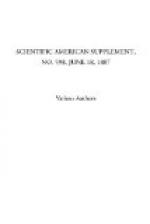Mr. Krupp, it is said, is very proud of his two power hammers, which he has named Max and Fritz. But, on the whole, these two apparatus are only fifty ton ones, and have a fall of but ten feet. Now, Creusot and St. Chamond each has a hundred ton steam hammer with a fall of 16 feet, accompanied with four furnaces and four cranes.
[Illustration: FIG. 2.—3,300 POUND PROJECTILE OF A KRUPP GUN IN COURSE OF MANUFACTURE.]
But why proceed to the manufacture of monstrous guns, like those that Mr. Krupp has just produced, or meditates producing in the future; guns of such a caliber can be used only in special cases—in battery on the coast or on board of a ship. It is not with materiel of this kind that war is waged; it is with field pieces. Our ultra-Vosges neighbors well know this.
One of the reasons that the war that very recently threatened us did not break out, was because the Germans could not fail to see that their field materiel was not as powerful as ours; that the shell of our 31/2 inch gun weighs 171/2 pounds, while that of their heavy 31/2 inch gun does not weigh 15. Now, this difference has its value.
Hunters well know what importance it is necessary to attach to the number of the ball that they use.
This granted, it is well to observe that the net cost of the “40 cm. kanone L/40” must not be less than $300,000 or $400,000. Now, on the interest of such a sum we could have from ten to fifteen complete batteries, that is to say, comprising, in addition to the sixty or eighty guns, all the necessary accessories, such as carriages, limbers, caissons, harness, etc.




